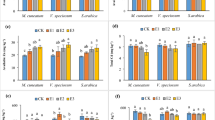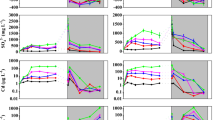Abstract
Barium (Ba) is a non-essential element that can cause toxicity in living organisms and environmental contamination. Plants absorb barium predominantly in its divalent cationic form Ba2+. Sulfur (S) can decrease the availability of Ba2+ in the soil by causing its precipitation as barium sulfate, a compound known for its very low solubility. The objective of this study was to evaluate the effect of soil sulfate supply in soil Ba fractions, as well as on plant growth, and Ba and S uptake by lettuce plants grown in artificially Ba-contaminated soil under greenhouse conditions. The treatments consisted of five Ba doses (0, 150, 300, 450, and 600 mg kg−1 Ba, as barium chloride) combined with three S doses (0, 40, and 80 mg kg−1 S, as potassium sulfate). The treatments were applied to soil samples (2.5 kg) and placed in plastic pots for plant cultivation. The Ba fractions analyzed were extractable-Ba, organic matter-Ba, oxides associated-Ba, and residual-Ba. The results indicate that the extractable-Ba fraction was the main one responsible for Ba bioavailability and phytotoxicity, probably corresponding to the exchangeable Ba in the soil. The dose of 80 mg kg−1 of S reduced extractable-Ba by 30% at higher Ba doses while it increased the other fractions. Furthermore, S supply attenuated the growth inhibition in plants under Ba exposure. Thus, S supply protected the lettuce plants from Ba toxicity by reduction of Ba availability in soil and plant growth enhancement. The results suggest that sulfate supply is a suitable strategy for managing Ba-contaminated areas.
Graphical Abstract








Similar content being viewed by others
Data Availability
All data generated or analyzed in this research are included in this article.
References
Ajwa HA, Tabatabai MA (1993) Comparison of some methods for determination of sulfate in soils. Commun Soil Sci Plant Anal 24:1817–1832. https://doi.org/10.1080/00103629309368920
Antoniadis V, Levizou E, Shaheen SM et al (2017) Trace elements in the soil-plant interface: phytoavailability, translocation, and phytoremediation–a review. Earth-Science Rev 171:621–645. https://doi.org/10.1016/j.earscirev.2017.06.005
Capaldi FR, Gratão PL, Reis AR et al (2015) Sulfur metabolism and stress defense responses in plants. Trop Plant Biol 8:60–73. https://doi.org/10.1007/s12042-015-9152-1
Cappuyns V (2018) Barium (Ba) leaching from soils and certified reference materials. Appl Geochemistry 88:68–84. https://doi.org/10.1016/j.apgeochem.2017.05.002
CONAMA (Brazilian National Environment Council) (2005) Resolução CONAMA no 357. http://pnqa.ana.gov.br/Publicacao/resolucao_conama_n_357.pdf
CONAMA (Brazilian National Environment Council) (2009) Resolução CONAMA no 420. http://www.mma.gov.br/port/conama/legiabre.cfm?codlegi=620
da Silva Ferreira M, MPF F, Pacheco AA et al (2020) Risk assessment of trace elements pollution of Manaus urban rivers. Sci Total Environ 709:134471. https://doi.org/10.1016/j.scitotenv.2019.134471
de Anicésio ÉCA, Monteiro FA (2022) Potassium reduces oxidative stress in tanzania guinea grass under cadmium toxicity. Environ Sci Pollut Res 29:1184–1198. https://doi.org/10.1007/s11356-021-15620-9
de Carvalho CFM, Viana DG, Pires FR et al (2019) Phytoremediation of barium-affected flooded soils using single and intercropping cultivation of aquatic macrophytes. Chemosphere 214:10–16. https://doi.org/10.1016/j.chemosphere.2018.09.096
de Souza Cardoso AA, de Lima Gomes FT, JRR A et al (2022) Sulfate availability and soil selenate adsorption alleviate selenium toxicity in rice plants. Environ Exp Bot 201:104971. https://doi.org/10.1016/j.envexpbot.2022.104971
Corrêa LFF, Hao J, Neerup R et al (2022) Review of barium sulphate solubility measurements. Geothermics 104:102465. https://doi.org/10.1016/j.geothermics.2022.102465
de Souza Cardoso AA, Monteiro FA (2021a) Sulfur supply effects on production and mineral nutrition of Tanzania guinea grass under barium levels in nutrient solution. J Plant Nutr 44:801–813. https://doi.org/10.1080/01904167.2021.1871751
de Souza Cardoso AA, Monteiro FA (2021b) Sulfur supply reduces barium toxicity in Tanzania guinea grass (Panicum maximum) by inducing antioxidant enzymes and proline metabolism. Ecotoxicol Environ Saf 208:111643. https://doi.org/10.1016/j.ecoenv.2020.111643
Ferreira AD, Viana DG, Egreja Filho FB et al (2019) Phytoremediation in flooded environments: dynamics of barium absorption and translocation by Eleocharis acutangula. Chemosphere 219:836–844. https://doi.org/10.1016/j.chemosphere.2018.12.074
Ferreira DF (2019) Sisvar: a computer analysis system to fixed effects split plot type designs. Rev Bras Biometria 37:529. https://doi.org/10.28951/rbb.v37i4.450
Gonçalves JM, Monteiro FA (2022) Biomass production and uptake of sulfur, chromium and micronutrients by Tanzania guinea grass grown with sulfur and chromium. Environ Geochem Health. https://doi.org/10.1007/s10653-022-01323-8
Gong Y, Zeng Z, Cheng W et al (2020) Barium isotopic fractionation during strong weathering of basalt in a tropical climate. Environ Int 143:105896. https://doi.org/10.1016/j.envint.2020.105896
He C, Li M, Liu W et al (2014) Kinetics and equilibrium of barium and strontium sulfate formation in marcellus shale flowback water. J Environ Eng 140:B4014001. https://doi.org/10.1061/(asce)ee.1943-7870.0000807
Huang L, Yang X, Xie Z et al (2021) Residual effects of sulfur application prior to oilseed rape cultivation on cadmium accumulation in brown rice under an oilseed rape–rice rotation pot experiment. Ecotoxicol Environ Saf 225:112765. https://doi.org/10.1016/j.ecoenv.2021.112765
Ippolito JA, Barbarick KA (2006) Biosolids affect soil barium in a dryland wheat agroecosystem. J Environ Qual 35:2333–2341. https://doi.org/10.2134/jeq2006.0076
Kabata-Pendias A (2010) Trace elements in soils and plants, 4th edn. CRC Press, Boca Raton
Ketegenov T, Kamunur K, Batkal A et al (2022) Recent advances in the preparation of barium sulfate nanoparticles: a mini-review. ChemEngineering 6:1–18. https://doi.org/10.3390/chemengineering6020030
Kopriva S, Malagoli M, Takahashi H (2019) Sulfur nutrition: impacts on plant development, metabolism, and stress responses. J Exp Bot 70:4069–4073. https://doi.org/10.1093/jxb/erz319
Kravchenko J, Darrah TH, Miller RK et al (2014) A review of the health impacts of barium from natural and anthropogenic exposure. Environ Geochem Health 36:797–814. https://doi.org/10.1007/s10653-014-9622-7
Lamb DT, Matanitobua VP, Palanisami T et al (2013) Bioavailability of barium to plants and invertebrates in soils contaminated by barite. Environ Sci Technol 47:4670–4676. https://doi.org/10.1021/es302053d
Llugany M, Poschenrieder C, Barceló J (2000) Assessment of barium toxicity in bush beans. Arch Environ Contam Toxicol 39:440–444. https://doi.org/10.1007/s002440010125
McGrath SP, Cunliffe CH (1985) A simplified method for the extraction of the metals Fe, Zn, Cu, Ni, Cd, Pb, Cr, Co and Mn from soils and sewage sludges. J Sci Food Agric 36:794–798. https://doi.org/10.1002/jsfa.2740360906
Melo LCA, da Silva EB, Alleoni LRF (2014) Transfer of cadmium and barium from soil to crops grown in tropical soils. Rev Bras Ciência do Solo 38:1939–1949. https://doi.org/10.1590/S0100-06832014000600028
Myrvang MB, Bleken MA, Krogstad T et al (2016) Can liming reduce barium uptake by agricultural plants grown on sandy soil? J Plant Nutr Soil Sci 179:557–565. https://doi.org/10.1002/jpln.201600104
Nogueirol RC, Alleoni LRF (2013) Sequential extraction and speciation of Ba, Cu, Ni, Pb and Zn in soil contaminated with automotive industry waste. Chem Speciat Bioavailab 25:34–42. https://doi.org/10.3184/095422913X13584417355199
Peana M, Medici S, Dadar M et al (2021) Environmental barium: potential exposure and health-hazards. Arch Toxicol 95:2605–2612. https://doi.org/10.1007/s00204-021-03049-5
Rabêlo FHS, da Silva BKDA, Borgo L et al (2018) Enzymatic antioxidants—relevant or not to protect the photosynthetic system against cadmium-induced stress in Massai grass supplied with sulfur? Environ Exp Bot 155:702–717. https://doi.org/10.1016/j.envexpbot.2018.08.020
Siddiqui MH, Alamri S, Alsubaie QD et al (2019) Potential roles of melatonin and sulfur in alleviation of lanthanum toxicity in tomato seedlings. Ecotoxicol Environ Saf 180:656–667. https://doi.org/10.1016/j.ecoenv.2019.05.043
Sleimi N, Kouki R, Hadj Ammar M et al (2021) Barium effect on germination, plant growth, and antioxidant enzymes in Cucumis sativus L. plants. Food Sci Nutr 9:2086–2094. https://doi.org/10.1002/fsn3.2177
USDA (United States Department of Agriculture) (1999) Soil taxonomy: a basic system of soil classification for making and interpreting soil surveys. U.S. Dep. Agric. Handb, USA, pp 436–886
USEPA (United States Environmental Protection Agency) (2004) National recommended water quality criteria. https://www.epa.gov/sites/default/files/2015-06/documents/nrwqc-2004.pdf
USEPA (United States Environmental Protection Agency) (2005) Ecological soil screening levels for barium. https://rais.ornl.gov/documents/eco-ssl_barium.pdf
Viana DG, Egreja Filho FB, Pires FR, et al (2021) In situ barium phytoremediation in flooded soil using Typha domingensis under different planting densities. Ecotoxicol Environ Saf 210:0–7. https://doi.org/10.1016/j.ecoenv.2021.111890
WHO (World Health Organization) (2022) Chemical fact sheets: barium. https://www.who.int/publications/m/item/chemical-fact-sheets%2D%2Dbarium
Acknowledgements
The authors thank the CNPq (Conselho Nacional de Desenvolvimento Científico e Tecnológico) for financial support for the research project and scholarship to the first author [155319/2017-5]. They also thank FAPEMIG (Fundação de Amparo à Pesquisa do Estado de Minas Gerais) and CAPES (Coordenação de Aperfeiçoamento de Pessoal de Nível Superior) for their funding support, as well as the participants of the Plant Nutrition Study Group (GENP-UFLA), for help in the research project.
Funding
This work was supported by CNPq (Conselho Nacional de Desenvolvimento Científico e Tecnológico) [155319/2017-5], FAPEMIG (Fundação de Amparo à Pesquisa do Estado de Minas Gerais), and CAPES (Coordenação de Aperfeiçoamento de Pessoal de Nível Superior).
Author information
Authors and Affiliations
Contributions
Conceptualization: AASC, VF, MLSS. Methodology: AASC, LRGG, VF, MLSS. Validation: all authors. Investigation: all authors. Formal analysis: AASC. Visualization: AASC, AAL. Writing—original draft: AASC. Resources: LRGG, VF, MLSS. Supervision: LRGG, VF, MLSS. Project administration: MLSS. Writing—review and editing: all authors.
Corresponding author
Ethics declarations
Ethical approval
Not applicable.
Consent to participate
Not applicable.
Consent to publish
Not applicable.
Competing interests
The authors declare no competing interests.
Additional information
Responsible Editor: Gangrong Shi
Publisher’s note
Springer Nature remains neutral with regard to jurisdictional claims in published maps and institutional affiliations.
Supplementary information
Rights and permissions
Springer Nature or its licensor (e.g. a society or other partner) holds exclusive rights to this article under a publishing agreement with the author(s) or other rightsholder(s); author self-archiving of the accepted manuscript version of this article is solely governed by the terms of such publishing agreement and applicable law.
About this article
Cite this article
de Souza Cardoso, A.A., Nunes, A.P.P., Batista, É.R. et al. Sulfate supply decreases barium availability, uptake, and toxicity in lettuce plants grown in a tropical Ba-contaminated soil. Environ Sci Pollut Res 30, 53938–53947 (2023). https://doi.org/10.1007/s11356-023-25960-3
Received:
Accepted:
Published:
Issue Date:
DOI: https://doi.org/10.1007/s11356-023-25960-3




